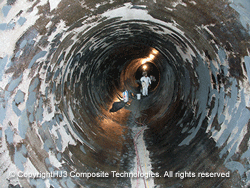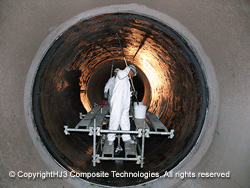Summer Weather Causes Water Main Breaks
Combating Water Main Breaks with Carbon Fiber Solutions
As summer approaches, many cities in northern regions are facing the aftermath of a harsh winter. Record low temperatures and heavy snowfall have left infrastructure under significant stress, and now, as the weather warms, new challenges are emerging—like melting snow runoff and water main breaks. This time of year is often called "water main break season," a recurring issue that affects communities worldwide. In Prince Albert, Saskatchewan, a persistent water main break has been flooding the streets for over a month, causing disruption and concern. The Causes Behind Water Main Breaks One of the primary causes of water main breaks is the freeze-thaw cycle. As the ground thaws, it can shift, putting pressure on underground pipes. Combined with aging infrastructure—some pipes are nearly 100 years old—this creates a perfect storm for failures. In Prince Albert alone, there have been 19 water main breaks this season, with more expected. City officials are working to develop a long-term plan, acknowledging that the extreme cold last winter placed immense strain on the underground systems. Corrosion: A Costly and Ongoing Problem Corrosion in pre-stressed concrete cylinder pipes (PCCP) is a major issue across North America. According to a 2002 study, corrosion costs U.S. water and wastewater systems over $50 billion annually. On average, there are 850 water main breaks each day, costing more than $3 billion in repairs. Leaks from these breaks result in the loss of about 2.5 trillion gallons of drinking water per year—roughly 17% of all water pumped in the U.S. Shockingly, 90% of this loss is due to corrosion in aging pipes. A 2012 study by Utah State University found that 43% of water mains in the U.S. are between 20 and 50 years old, while 22% are over 50 years old. With almost half of the one million miles of pipelines nearing the end of their service life, replacement costs could exceed $1 trillion over the next 25 years. However, with limited funding available, we need innovative solutions to extend the lifespan of our aging infrastructure. HJ3's CarbonSeal: A Smart Repair Alternative HJ3’s CarbonSeal carbon fiber solution offers an effective way to repair damaged pipes without the high cost of full replacement. One notable example involved a cracked water pipe at a coal-fired power plant. The internal concrete lining of a 120-inch diameter pipe had developed cracks, allowing water to seep in and corrode the pre-stressed wires. Faced with the expensive option of replacing the entire 750-foot section, the plant chose to use HJ3’s CarbonSeal system instead. The CarbonSeal Repair Process The repair began with sandblasting the pipe’s surface, followed by injecting polyurethane foam into the leaks. After priming, the CarbonSeal fabric was carefully applied, and a protective top coat was added to ensure a leak-free finish. In just 11 days, the entire 750 feet of pipe was fully repaired, restoring its ability to handle internal stresses. This method saved 50% compared to other repair techniques and 65% compared to replacement costs. It also prevented six tons of concrete from going to landfills. The system has performed reliably for eight years, with the client expressing strong satisfaction with the support provided throughout the project. Explore CarbonSeal for Your Pipe Repairs If you're dealing with underground pipe issues and want to learn more about HJ3’s CarbonSeal reinforcement systems, contact HJ3 today. Their advanced solutions offer a durable, cost-effective alternative to traditional repairs and replacements.
![PNM-1[1]](http://bsg-i.nbxc.com/blog/0cea1ad9232aeaed06638a149fc83342.jpeg)

BOPP Thermal Laminating Film is a popular and versatile choice for enhancing the durability and appearance of printed materials. This high-quality film provides superior protection against wear, moisture, and fading, making it ideal for a wide range of applications in industries such as packaging, printing, and marketing. BOPP Thermal Laminated Film offers excellent clarity and a glossy finish, adding vibrancy to colors while improving the longevity of the printed content. The BOPP Lamination Film is available in various thicknesses and finishes, including glossy and matte options, allowing businesses to choose the perfect solution for their specific needs. BOPP Film is known for its flexibility, strength, and resistance to environmental factors, making it suitable for everything from book covers to product labels and promotional materials. Whether you’re looking for enhanced protection or a high-end visual appeal, BOPP Thermal Laminating Films deliver outstanding performance and value.
BOPP Thermal Laminated Film,BOPP Lamination Film,BOPP Film
GR (SHANDONG) NEW MATERIAL CO., LTD , https://www.grmaterial-film.com